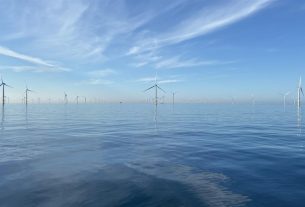The Netherlands – Of course, the transition calls for completely new production methods, but the zero-emission factories will not be there overnight. Solutions are therefore also needed to give existing plants in the chemical, steel and fertilizer sectors a smaller footprint. One example is SEWGS, a technique developed by TNO to separate residual gases and capture CO2. A potential linchpin in the transition of the industry.
Puertollano in southern Spain is currently home to Europe’s largest electrolyzer for hydrogen production, with a capacity of 20 megawatts. It runs entirely on solar energy. With this green hydrogen, producer Fertiberia first makes ammonia and then fertilizer. A very elegant and hopeful development.
However, it will be some time before a significant proportion of the world’s fertilizer is produced in this way. In Puertollano it is now only ten percent of the total production. The rest of the fertilizer is still made from hydrogen from natural gas and nitrogen from the air. Fertiberia has plans to scale up the green route at multiple locations, but that will take time.
Innovative technology
Climate change doesn’t wait. Therefore, it makes sense to also come up with solutions that reduce CO2 emissions in the shorter term. For example, end-of-pipe solutions that strip existing plants of their CO2 emissions, or decarbonize them.
Joey Dobrée of Stamicarbon, part of the Maire Tecnimont group and designer of fertilizer plants, sees several steps to reduce CO2 emissions from fertilizer production. ‘For decades we have been doing a lot to reduce the energy consumption of existing plants. We now have several successful technologies for that as well. We are also looking for ways to reduce the CO2 emissions of these factories. Capture, for example with innovative techniques such as SEWGS, is also part of this. And the third route is the use of innovative technology, which means no more CO2 emissions at all.’
Blissful solution
One of the possibilities is the use of green hydrogen, as at Fertiberia in Puertollano. Dobrée: ‘A lot is being said about this, but unfortunately not a great deal has been done yet. The first steps have been taken, but the road is still long. It’s going to be difficult to make any major steps in the short term to replace existing plants with completely green installations.
This is why, in the shorter and medium term, Stamicarbon is looking primarily at capturing and recycling CO2. ‘SEWGS is a promising way to capture and reuse CO2. It can even play a crucial role. With SEWGS we can even use captured CO2, for example from the steel industry, to produce urea in a reaction with ammonia. It’s not the all-satisfying solution, but you can reduce the CO2 footprint from both industries.’
Water vapor
In the steel industry, too, there are multiple routes toward sustainability. Eric de Coninck, general manager at Arcelor Mittal distinguishes three. First, circular steel. Scrap can be remelted using sustainably generated energy. De Coninck: ‘Europe is currently exporting huge quantities of scrap to Turkey. We could also keep it here and melt it down ourselves using green energy. In some countries it is even permitted to use nuclear power for this purpose.’
However, the demand for steel is still growing. That is why the production of new, virgin steel from ore will also be needed in the future. Arcelor Mittal sees two paths for this. The most innovative is the use of natural gas and, in time, green hydrogen. As long as natural gas is used, there will still be emissions of CO2, albeit less. To reduce these emissions, therefore, capture is needed, combined with storage or reuse. As soon as natural gas is replaced by blue or green hydrogen, there will only be emissions of water vapour.
Building blocks
Another possibility is to maintain the existing blast furnaces and to capture and reuse the residual gases. The advantage is that existing installations can be retained. The residual gases consist of hydrogen, carbon monoxide (CO) and carbon dioxide (CO2). The hydrogen and carbon monoxide are already used on a large scale as fuel. De Coninck: ‘Many steel companies are already capturing the gases. The trick, of course, is to do that as effectively as possible. TNO’s SEWGS technology could help us separate hydrogen, approximately sixty percent, carbon monoxide and carbon dioxide. We can then work with the chemical industry to combine these building blocks. We are working with Dow to produce naphtha from this. For example, ethanol with Lanzatech. Polyols with Covestro. And of course the excess CO2 has to be stored.’
How SEWGS works
The SEWGS process combines two process steps in one reactor. The first process is known as the water-gas-shift reaction, in which steam converts carbon monoxide into carbon dioxide and hydrogen. Because this is a so-called equilibrium reaction, portions of the desired substances hydrogen and carbon dioxide will react back into the undesired substances, water and carbon monoxide. The reaction keeps itself in equilibrium and it is impossible to achieve complete conversion. To prevent this undesirable back reaction as much as possible, conventional processes usually use a lot of steam.
However, this is not necessary if a company uses the SEWGS process. The second process prevents this undesirable reaction. The reactor contains a solid adsorption material that selectively binds acidic substances. Carbon dioxide therefore adheres to the surface of the adsorbent material. As a result, the carbon dioxide can no longer react with hydrogen. An additional advantage is that other acidic substances, such as hydrogen sulfide, also bind to the surface of the adsorbent.
The combination of these processes in one reactor results in a much more efficient process, with less energy being lost. Most of the captured carbon dioxide is simply released when the pressure in the reactor is reduced, but the last bit of CO2 remaining in the adsorbent requires a steam flush. The heat from the process is suitable for this. And because the solid adsorbent can tolerate high temperatures, such a steam flush is quite possible.





